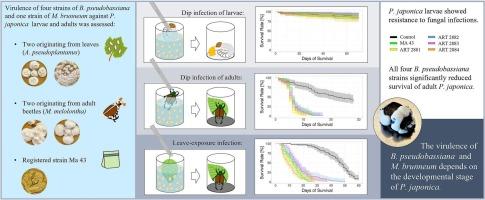假球孢白僵菌对日本菊的致病性取决于昆虫的发育阶段
IF 3.4
2区 农林科学
Q2 BIOTECHNOLOGY & APPLIED MICROBIOLOGY
引用次数: 0
摘要
Popillia japonica是一种入侵的多食性甲虫,以400多种寄主植物为食,对北美、意大利北部和瑞士南部的侵染地区的主要作物造成了损害。目前,对粳稻的控制主要依赖于合成杀虫剂。近年来,假球孢白僵菌被认为是日本金龟的原生亲缘种Melolontha成虫的优势病原体。在几种昆虫、土壤和植物叶片上均检测到假球孢白僵菌,表明其对地面环境条件的适应性。本研究评估了日本假球孢白僵菌4株(ART 2881、ART 2882、ART 2883、ART 2884)和一株(Ma 43)对日本假球孢白僵菌成虫和幼虫的存活率。当将所有真菌菌株浸泡在分生孢子悬浮液或暴露于真菌接种的叶片时,所有真菌菌株都导致粳稻成虫的中位存活率显著降低3 - 5倍,而ART 2884在两项试验中都是最毒的菌株。相比之下,没有一种真菌分离物降低了幼虫的存活率,70天后的死亡率为2 - 8% %。从野外采集的甲虫中,我们获得了天然的白僵菌分离株,其中一些被鉴定为假球孢白僵菌,这表明该真菌可能在自然感染情况下发挥作用。假球孢白僵菌具有较高的体外毒力、在地上条件下的生存能力和在田间对粳稻的发生情况,表明该真菌具有作为粳稻成虫生物防治剂(BCA)的潜力。本文章由计算机程序翻译,如有差异,请以英文原文为准。

Pathogenicity of the fungus Beauveria pseudobassiana for Popillia japonica depends on the developmental stage of the insect
Popillia japonica is an invasive, polyphagous beetle feeding on more than 400 host plants and responsible for major crop damage in infested regions in North America, northern Italy and southern Switzerland. Currently, control of P. japonica largely relies on synthetic insecticides. Recently, Beauveria pseudobassiana has been described as the dominant pathogen on Melolontha melolontha adults, a native scarabaeoid relative of P. japonica. B. pseudobassiana has been detected on several insect species, in soil but also on plant leaves indicating its adaptation to environmental conditions above ground.
We evaluated survival of P. japonica adults and larvae exposed to four strains of B. pseudobassiana (ART 2881, ART 2882, ART 2883, ART 2884) and a M. brunneum strain (Ma 43), registered as control agent against several Scarabaeidae species in Europe. All the fungal strains led to a significant three-to-five-fold reduction in the median survival of P. japonica adults, when dipped in conidia suspensions or exposed to fungus inoculated leaves, while ART 2884 was in both tests the most virulent strain. In contrast, none of the fungal isolates reduced larval survival, with mortality rates of 2–8 % after 70 days. From field-collected beetles, we obtained natural Beauveria isolates, some of which were identified as B. pseudobassiana, indicating a possible role of the fungus in natural infection scenarios. The high in vitro virulence of B. pseudobassiana together with its competence for above ground conditions and occurrence on P. japonica in the field indicates potential of this fungus as biological control agent (BCA) against adult P. japonica.
求助全文
通过发布文献求助,成功后即可免费获取论文全文。
去求助
来源期刊

Biological Control
生物-昆虫学
CiteScore
7.40
自引率
7.10%
发文量
220
审稿时长
63 days
期刊介绍:
Biological control is an environmentally sound and effective means of reducing or mitigating pests and pest effects through the use of natural enemies. The aim of Biological Control is to promote this science and technology through publication of original research articles and reviews of research and theory. The journal devotes a section to reports on biotechnologies dealing with the elucidation and use of genes or gene products for the enhancement of biological control agents.
The journal encompasses biological control of viral, microbial, nematode, insect, mite, weed, and vertebrate pests in agriculture, aquatic, forest, natural resource, stored product, and urban environments. Biological control of arthropod pests of human and domestic animals is also included. Ecological, molecular, and biotechnological approaches to the understanding of biological control are welcome.
 求助内容:
求助内容: 应助结果提醒方式:
应助结果提醒方式:


